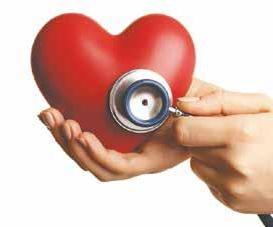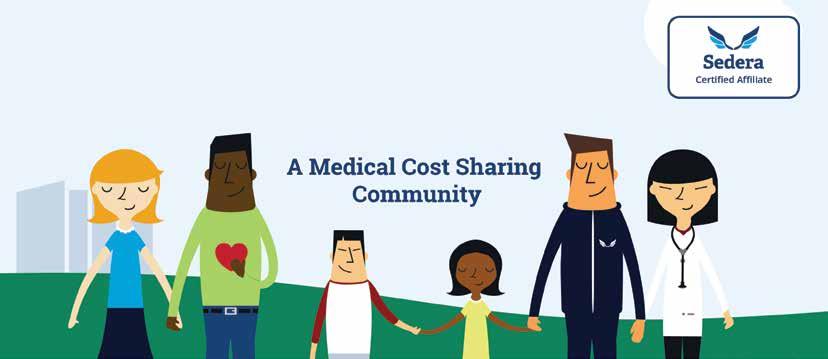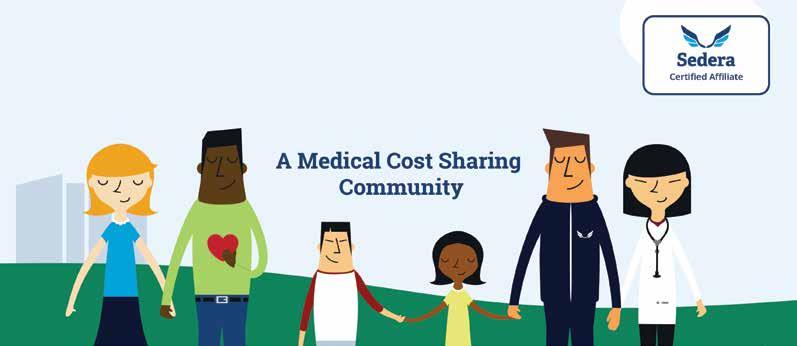
19 minute read
global briefs
global briefs Big Blow
Climate Change Makes Hurricane Destruction Worse
Advertisement
A study from the Okinawa Institute of Science and Technology Graduate University published in Nature predicts that hurricanes will remain stronger and persist lonnasa/Unsplash.com ger after making landfall, causing greater and more widespread destruction, because of ocean waters heated by climate change. In the 1960s, hurricanes lost 75 percent of their energy in the first day after making landfall, but more recent hurricanes lost only about 50 percent of their energy in that same time.
Hurricanes feed off heat energy from the sea and rapidly lose strength once they reach land. Pinaki Chakraborty, a senior author of the study, and its lead author, Ph.D. student Lin Li, analyzed data on storms that made landfall after forming in the North Atlantic between 1967 and 2018. They found that how slowly the storms weakened closely matched changes in sea surface temperatures during the same period. From computer simulations of hurricanes, they discovered that hotter temperatures allowed the hurricanes to hold on to more moisture, which they could continue to use as a source of heat energy once they reached land.
Tiny Invaders
Plastic Particles Ingested in Food and Water
likely consumed annually. The results are 50,000 particles per year for adults and 40,000 for children. When inhalation is included, the estimate rises to between 74,000 and 121,000 particles per year for adults. Even these figures are likely underestimated, because the foods in the studies make up only 15 percent of the typical American caloric intake.
The particles’ effect on the human body is not yet understood. Another study revealed that some plastic is expelled from the body in feces. But there is also evidence that it gets absorbed, and that the tiniest particles can enter the bloodstream and lymphatic system, which could affect immune response and aid transmission of toxic chemicals. Researchers at the University of Victoria, British Columbia, estimate people that drink victoria strukovskay/Unsplash.com bottled water ingest an additional 90,000 microplastic particles annually compared to 4,000 microplastics for those that drink only tap water. Food is contaminated with plastic as well, which we also ingest. The researchers took data from 26 studies that measured plastic in salt, beer, sugar, fish, shellfish, water and urban air, and combined it with U.S. dietary guidelines to calculate how many particles people
Outdoor Fun
Childhood Immunity Enhanced by Natural Environment
At the University of Helsinki, in Finland, a new project recorded in the journal Science Advances found that switching a child’s visionpic/Pexels.com playground from gravel to natural forest floor could foster a better immune system within a month by exposing them to a greater variety of skin and gut bacteria. The researchers studied 75 children between 3 and 5 years of age at 10 daycare centers in two Finnish cities to see how a change in their playing environment altered their skin and gut microbiota, as well as immune markers in their blood.
Four centers turned their gravel playgrounds into fields of forest floor, soil and grasses, while three already had that setting. Three others kept their existing gravel playground. One month after the changes were made, scientists collected samples of skin, blood and feces from the children. In just a few weeks, microbiota of the children at the renovated daycare centers quickly shifted to become more like the microbiomes of children that attended centers that already had more natural play surfaces. The children at the renovated daycare centers developed a higher ratio of the anti-inflammatory proteins to proinflammatory proteins in their blood, indicating that their immune systems were in better shape.
America Last
Europe Tightens Methane Emission Monitoring, But U.S. Does Not
The United Nations reported that atmospheric levels of the greenhouse gas methane reached a record markus distelrath/Pexels.com high, and 62 oil and gas companies acting as the Climate and Clean Air Coalition’s Oil and Gas Methane Partnership (OGMP) have adopted a new framework to report methane emissions. None of the participating oil and gas companies in the OGMP are in the United States. The initiative, managed by the U.N. Environment Programme, asks companies to report methane emissions from both core operations and joint ventures. The OGMP represents about 30 percent of global oil and gas production and seeks to deliver a 45 percent reduction in the oil and gas industry’s methane emissions by 2025.
Approximately 60 percent of methane emitted into the atmosphere comes from manmade sources such as fossil fuels, landfills, biomass burning and agriculture. For the first time, companies are committing to regularly measure their methane emissions using strict, science-based standards, as opposed to engineering estimates, which have historically understated emissions. This newly adopted method involves field measurements and ongoing monitoring with drones and satellites.
Hard Knocks
Low-Carbon Cement Offsets Climate Change
into clinker, which is then ground and combined with other materials to make cement. In 2018, the Global Cement and Concrete Association, which represents about 30 percent of worldwide production, issued the industry’s first sustainability guidelines, a set of key measurements such as emissions and water usage intended to track performance improvements and make them transparent.
A variety of approaches are being explored and implemented to lower these worrisome carbon emissions. For example, CarbonCure, in Dartmouth, Nova Scotia, stores carbon dioxide captured from other industrial processes in concrete through mineralization, rather than releasing it into the atmosphere as a byproduct. Solidia, in Piscataway, New Jersey, uses a chemical process licensed from Rutgers University that has cut 30 percent of the carbon dioxide usually released in making cement. It uses more clay and less limestone and heat than typical processes. The manufacture of cement creates up to 8 percent of the total global carbon dioxide generated by humans, according to the Chatham life of pix/Pexels.com House, a London-based think tank. Four billion tons of cement are produced every year, but that figure is expected to rise to 5 billion tons in the next 30 years. The emissions result from the fossil fuels used to create heat for cement formation, as well as the chemical process in a kiln that transforms limestone
Stress Responses
Disaster Fatigue Influences Decisions
Extreme levels of stress from wildfires, darwin brandis/Adobesstock.com hurricanes, floods and the pandemic can induce “disaster fatigue”, a form of emotional exhaustion that may reshape how people make choices. Tara Powell, a behavioral health expert at the University of Illinois, UrbanaChampaign, states that there isn’t a single strategy for combating disaster fatigue, but current studies could help researchers and emergency planners customize interventions to aid specific communities and individuals, helping them prepare for impending disasters and recovery afterward. The condition can have major implications for emergency planners trying to encourage people to get out of harm’s way.
Jennifer Collins, a severe weather scientist at the University of South Florida, and her collaborators received more than 7,000 responses to a survey sent to Florida residents before the last hurricane season began. Nearly 75 percent of respondents perceived the hypothetical risk of evacuating to a shelter and potentially exposing themselves to COVID-19 as more dangerous than sheltering in place. But after September’s Hurricane Laura, Collins saw shifting perceptions in 300 responses—some that said they had sheltered in place during the storm admitted they would not do so again the next time.
Live a Heart-Healthy Lifestyle
Integrative Cardiologists on Preventing Heart Disease
by Ronica O’Hara

Cardiology has made mind-boggling advances in efficiently repairing everything from clogged arteries to floppy mitral valves and even replacing the entire failing heart itself. Yet the stubborn fact remains that almost half of all Americans suffer from cardiovascular disease, killing one in four of us, and those numbers are rising. Research shows that simple lifestyle changes can prevent 80 percent of these deaths, but many cardiologists typically reach for a prescription pad rather than explore diet, exercise and other prevention options with their patients.
“Medicine can be life-saving, but optimal heart health can’t come from medicine alone,” says cardiologist Stephen Devries, co-author of Integrative Cardiology. “There is a common belief among many physicians that patients generally don’t want to make lifestyle changes—an assumption that is often dead wrong and refuted by surveys of patients that show that the majority are looking to do exactly that.”
Los Angeles restauranteur and musician Gianni Neiviller, 54, is such a case. When he found holistic cardiologist Cynthia Thaik three years ago, he had already endured four major surgeries for gut illnesses; was suffering from obesity, high blood pressure, anxiety and depression; and was heavily abusing alcohol and marijuana. Thaik ordered tests that uncovered sleep apnea, and she encouraged him to turn to an all-organic diet, take vitamin and mineral supplements, exercise and practice mindfulness and meditation.
“At first it was all fairly hard, but as I started losing the pounds, my mind became more clear, and little by little, it all started getting a bit easier,” Neiviller says. He lost 86 pounds within a year, got sober and ceased taking blood pressure medication and using a sleep apnea machine. He now walks six miles a day; practices a hybrid
regimen of qigong, yoga and meditation; and is switching to a holistic health career. “When people try to push my buttons, they rarely succeed these days,” he smiles.
Rebounding into vibrant health is what integrative cardiologists like Devries and Thaik strive for. Also known as preventive or holistic cardiologists, they focus on guiding patients to change long-held, harmful, physical and emotional practices. Although they are comparatively few in number—probably no more than 100 nationally—these doctors are vocal and influential, imparting valuable advice about preventing and reversing heart disease through daily lifestyle choices.
Heart-Happy Eating
Substantial research affirms that one major line of defense against heart disease is what we put into our mouths every day, yet only 8 percent of cardiologists consider themselves capable to give nutritional advice, a survey showed. To counter that, Devries co-founded the Gaples Institute, a Naperville, Illinois, nonprofit that offers free nutritional training online to the public and nutritional accreditation for medical clinicians. Devries, who trained at Dr. Andrew Weil’s Center for Integrative Medicine at the University of Arizona, lectures internationally and recently authored What Your Doctor May Not Tell You About Cholesterol. “People have a lot more power over their heart health than they realize,” he says.
According to Devries, the name of a diet is not as important as the anti-inflammatory foods it should contain, such as “a wide variety of vegetables and fruit, plenty of beans, whole grains in place of refined, minimizing or eliminating meat (especially processed meat like bacon and sausage), minimizing added sugar (especially from sugar-sweetened beverages) and using small amounts of the most healthful oils, like extra-virgin olive oil.” And the evidence is increasing, he says, of “minimizing or eliminating animal products and getting most or all of your protein from highquality plant sources like beans, tofu, whole grains and nuts. Fish is one exception for which there is good evidence.”
He’s backed up by a November 2020 study of 220,000 adults published in the Journal of the American College of Cardiology. It concludes that those with diets high in red and processed meat, refined grains and sugary beverages had a 46 percent higher risk of heart disease and a 28 percent higher risk of stroke compared to those consuming anti-inflammatory diets rich in green and yellow vegetables, whole grains, coffee and tea.
Devries suggests that gradual, incremental changes to the diet may be easier than abrupt and dramatic choices. For example, he might recommend switching from sugary soda to flavored seltzer first, then trying lemon water and black tea with milk before opting for plain, green tea. Sipping a cup of green tea at least every other day reduces the risk of heart attacks and dying of heart disease by one-fifth, Chinese researchers report in the European Journal of Preventive Cardiology.
Powerful Supplements
As a young cardiologist frustrated by the revolving-door nature of his patients, Stephen Sinatra came upon an obscure 1982 study of coenzyme Q10 (CoQ10) that he realized could have saved the life of a favorite patient. This catalyzed his intensive studies into nutrition and bioenergetics that produced 17 books, including the bestselling Reverse Heart Disease Now and The Sinatra Solution. He helped formulate the new field of metabolic cardiology that proposes preventing and treating cardiovascular disease with nutraceuticals to improve energy production in heart cells.
In addition to suggesting a high-potency, multi-nutrient, fish oil, magnesium and vitamin C for prevention, he recommends four key nutrients that produce and use adenosine triphosphate (ATP), the body’s basic cellular fuel: YCoQ10 is synthesized in the body, but declines with age and statin use. It protects from the free radical damage linked to inflammation. Dosage: 90 to 250 milligrams (mg) daily for prevention, 180 to 360 mg for hypertension and 300 to 600 mg for heart failure. YL-carnitine ferries fatty acids to be oxidized to make ATP and moves toxic metabolites out of heart cells. Dosage: 1,000 to 1,500 mg in divided doses to prevent deficiency and up to 3,000 mg for heart disease. YMagnesium, required in all reactions involving ATP, is depleted by some gastrointestinal medications and diuretics. Dosage: at least 400 mg. YD-ribose is a naturally occurring sugar derivative of ATP that hastens energy regeneration. Dosage: five to seven grams (gm) daily as a preventive, seven to 10 gm daily for heart failure. In other nutrient news, adults that took glucosamine/chondroitin every day for a year or longer had a 65 percent reduction in cardiovascular-related deaths, reports West Virginia University researchers that analyzed 16 years of data from 16,686 adults.
Smart Testing
Preventive cardiologist Joel Kahn, the author of Your Whole Heart Solution and The Plant-Based Solution, says that lab tests typically prescribed by cardiologists and other doctors are inadequate. “Standard lab tests have not changed in 30 to 40 years, but science has,” he says. “For example, inflammation is now understood to be a fundamental process for most chronic diseases like heart disease and cancer. A simple lab test, hs-CRP, is available to measure inflammation. Very few doctors add this to their panel. When it is high, it leads to a search for why there is inflammation and diet, lifestyle and other measures to resolve it.”
After 25 years as a cardiologist treating heart-attack emergencies, Kahn, who is vegan, went back to college to study preventive cardiology and set up the Kahn Center for Cardiac Longevity, in Bingham Farms, Michigan, which focuses on dietary counseling and preventive screenings. His list of “must have” tests includes: YAdvanced cholesterol panel for a breakdown of LDL-cholesterol particle number and size, which is highly predictive of cardiovascular problems. YLipoprotein(a) cholesterol to detect a risk-elevating genetic form of cholesterol that’s present in about 20 percent of those tested.
YHigh-sensitivity C-reactive protein (hsCRP) to identify inflammation of blood vessels. YHemoglobin A1c (HbA1C) to obtain the three-month measure of sugar in hemoglobin, a marker of both diabetes and heart disease. YVitamin D to identify deficiencies linked to a higher risk of hypertension, heart failure, angina and heart attacks.
Move It or Lose It
The American Heart Association recommends 150 minutes per week of moderate-intensity aerobic activity (brisk walking, water aerobics, gardening, tennis, dancing) or 75 minutes of vigorous activity (running, jumping, swimming laps), as well as musclestrengthening activity (weights) at least two days a week.
Only 20 percent of adults exercise for the full 150 minutes per week, which may be why physical inactivity is a major factor in an estimated one-third of heart disease deaths. “I like to frame it as ‘being active’, because exercise sounds onerous,” Devries says. “Even a small amount of activity goes a long way—walking at a gentle pace 30 minutes a day confers very significant benefits. Up to a point, more can be better, but only for some people, and only to a point.”
Even moving a few minutes daily can add up. Doing 12-minute bursts of vigorous exercise favorably impacts 80 percent of the metabolites that govern such functions as oxidative stress, inflammation and vascular reactivity, reports a new study in Circulation. Just one hour a week of strength training significantly lowers the risk of heart attack, stroke and heart disease death, another study found. And simply holding thigh and calf stretches for 45 seconds for a total of five minutes daily improved arterial blood flow, reports a study in the Journal of Physiology.
The Emotional Heart
As a child in Myanmar, Thaik witnessed hands-on healing at a clinic she visited with her physician mother, but holistic care only entered her life after 20 years of practice as a frustrated cardiologist, when she was laid low by severe anemia that required transfusions and surgery. Today, the Harvard-trained cardiologist is the author of Your Vibrant Heart and founder of the Holistic Heart Healing Center, in Los Angeles, which integrates the medical model with lifestyle strategies and approaches like homeopathy and acupuncture.
“I very much believe that we are both physical beings and energetic or spiritual beings. Our physical makeup is closely intertwined with our mental and emotional makeup,” Thaik says. She counsels patients to practice the following: YMindfulness. “A mentor of mine, (life coach) Mary Morrisey, taught me to avoid the three Cs—complaining, comparing or criticizing. If you attempt to do this for even an hour, you will find that it is actually a hard task. Practicing this allows us to be acutely mindful of our thoughts.” YGratitude. “I wake up every morning and before my feet hit the floor, I make this statement five times and fill in five different answers: ‘I am so happy and grateful now that ...’” YReleasing. “I believe the most important ingredient to health and healing is the ability to release—to forgive self and others, to let go and abandon all of our negative thoughts, our self-limiting beliefs, our notions of right and wrong, our feelings of injustice and being wronged.” She advises, “When we can abandon all these beliefs and allow ourselves to float or drift unimpeded—imagine yourself on a tube in a lazy river—that is when healing within our bodies begins, when our parameters of stress and the hormones and neurotransmitters associated with stress start to down-regulate, and we can literally feel a wave of relaxation passing through our bodies. This will lower our heart rate, blood pressure, adrenaline and cortisol levels, thereby mitigating our risk of a heart attack or stroke.”
Ronica O’Hara, a natural health writer, can be contacted at OHaraRonica@gmail.com.
More Heart-Healthy Strategies
take long soaks. Middle-aged Japanese adults that took a daily bath in warm or hot water had a 28 percent lower risk of cardiovascular disease and a 26 percent lower risk of stroke than people that didn’t bathe in the tub more than twice a week, concludes a study in the journal Heart.
outdo each other. People that competed with each other to walk more steps ended up walking about 100 miles more in nine months than people that simply walked on their own, reports the JAMA Internal Medicine.
consider cannabidiol. This non-psychoactive form of cannabis has been shown in small lab studies to lower inflammation and ease arrhythmia. “CBD can help to reduce stress, lower blood pressure, improve anxiety and depression, reduce inflammation, improve glucose regulation, diminish pain and thereby lower our adrenergic (fight-orflight) tone,” says holistic cardiologist Cynthia Thaik.
brush a lot. In a 10-year Korean study, people that brushed their teeth three or more times a day had a 10 percent lower risk of atrial fibrillation and a 12 percent lower risk of heart failure.
sidestep pollution. Stay away from traffic and industrial areas when exercising. Even a few hours of exposure to the ultrafine particles generated by emissions may potentially trigger a nonfatal heart attack, reports research in Environmental Health Perspectives.

The importance of heart- vascular disease. healthy lifestyle behaviors It is also important for cannot be overstated. For people to know their numbers. the first time, since 2010 or so, An optimal cholesterol level the U.S. has seen a much slower should be less than 170. The optigrowth in life expectancy than mal HDL cholesterol level should comparable countries, and an be greater than 50. Target blood actual decline in recent years. pressures should be in the 120/80 Studies have demonstrated that range or less. It is also important stage is quite advanced and irreversible.if we do not smoke, maintain a body mass index of less than 25, Sreenivas Gudimetla to know our blood sugar level, as diabetes mellitus is a significant Healthy lifestyle behaviors have been shown to reduce the rate of advanceeat five servings of fruits and vegetables per risk factor for cardiovascular disease, and ment of cardiovascular diseases. It is vitally day and exercise greater than 150 minutes even considered a cardiovascular disease important to start when we are young and a week, cardiovascular event rates decrease equivalent. Healthy lifestyle behaviors such continue through adulthood. Doing so very significantly—around 40 percent over a as eating healthy, exercising and maintain- results in a markedly favorable impact on four-year period, ac- ing an appropriate mortality and symptomatic disease later in cording to studies. body weight strongly life. We cannot control our genetics, and we
Two specific diet reduce the risk of cannot always control our socioeconomic types—the Dietary development of Type status, which are also important contributors Approaches to Stop Hypertension (DASH) 2 diabetes later in life. Also, avoidance of to cardiovascular health. diet and the Mediterranean diet are felt to smoking is critical toward cardiovascular risk Individuals have a great deal of power be the best diets for cardiovascular disease reduction. for controlling their risk of cardiovascular prevention. These are plant-based diets rich A powerful point to make is that diseases, so it is vitally important to teach in fruits and vegetables, nuts, lean meats, healthy lifestyle behaviors make a far big- and encourage healthy lifestyle behaviors fish, poultry, whole grains, low- or non-fat ger difference in cardiovascular long-term early in life.dairy products and heart-healthy fats. The health than what healthcare providers do to DASH diet emphasizes foods that are lower treat people after they develop symptomatic in sodium and rich in potassium that could disease. It is important to remember that help lower blood pressure. The Mediter- once people develop symptoms of cardioranean diet was based on dietary choices in vascular disease (i.e., heart attacks, heart countries such as Greece and Italy, where the failure, strokes or other blood vessel-related population has a lower incidence of cardio- diseases), progression of the disease at that Cardiologist Sreenivas Gudimetla, M.D., practices at Texas Health Harris Methodist Hospital, in Fort Worth and the Texas Health Physicians Group. For more information, visit Tinyurl.com/Sreenivas GudimetlaMD.

Healthcare can be complicated & expensive.
We believe it should be affordable, efficient & transparent. We are not Insurance. We are Sedera. Let’s find out if we are a good match!
Leslie Allen 972.284.0709
Sedera.Community/LeslieAllen

A Medical Cost Sharing Community











